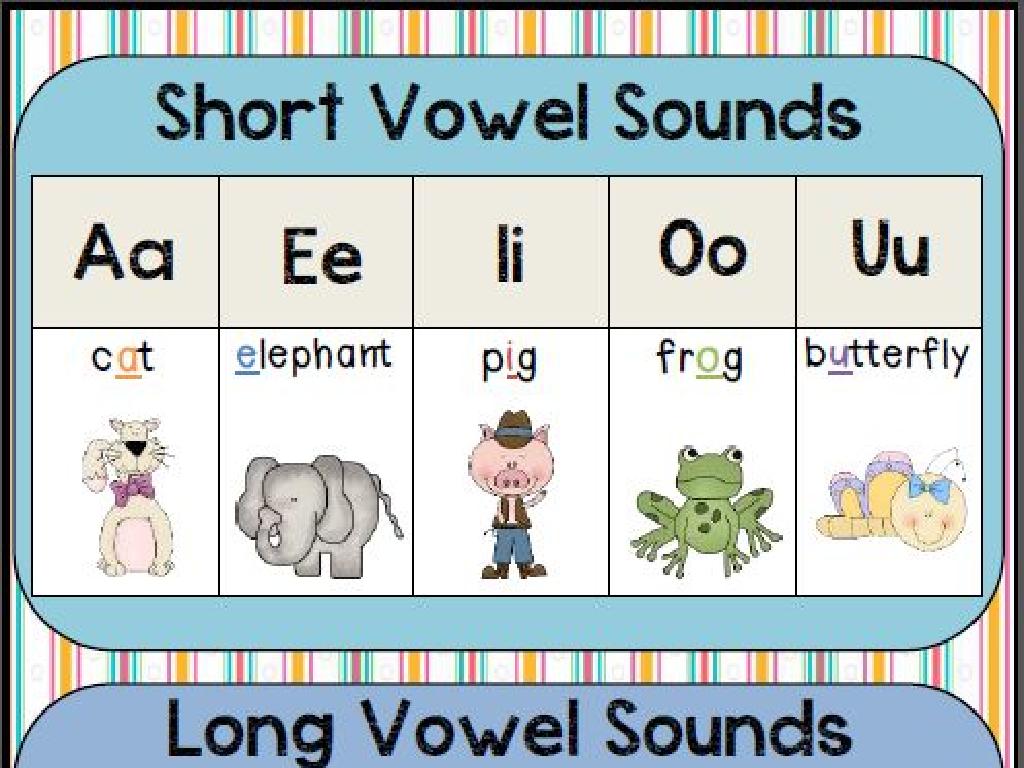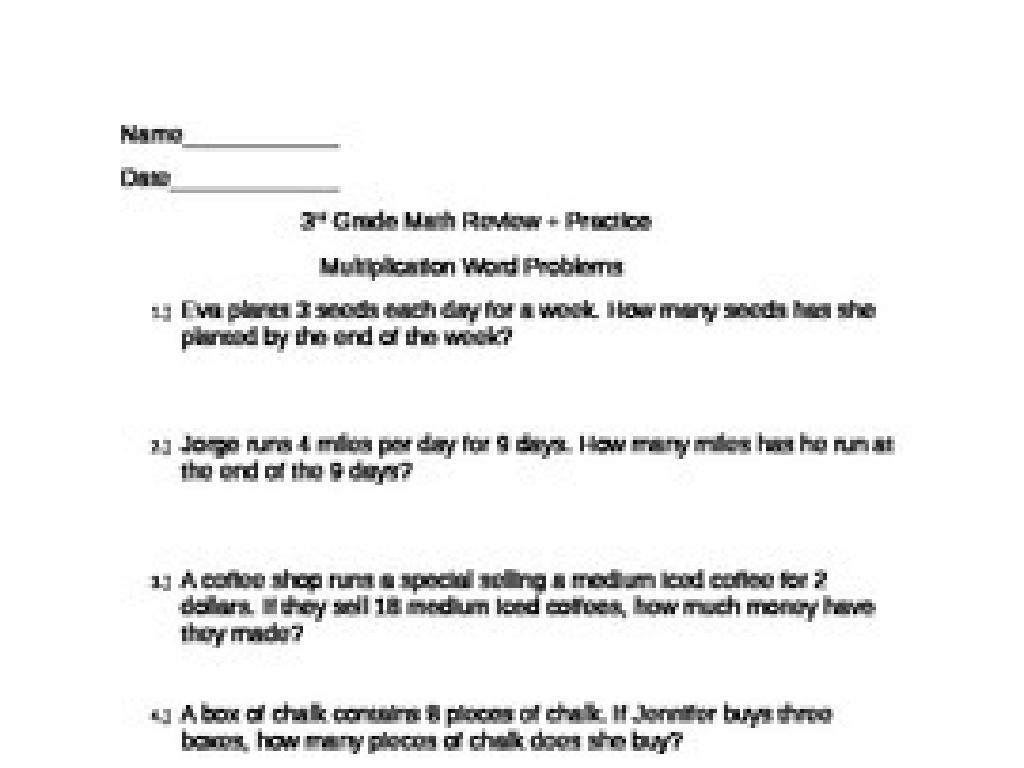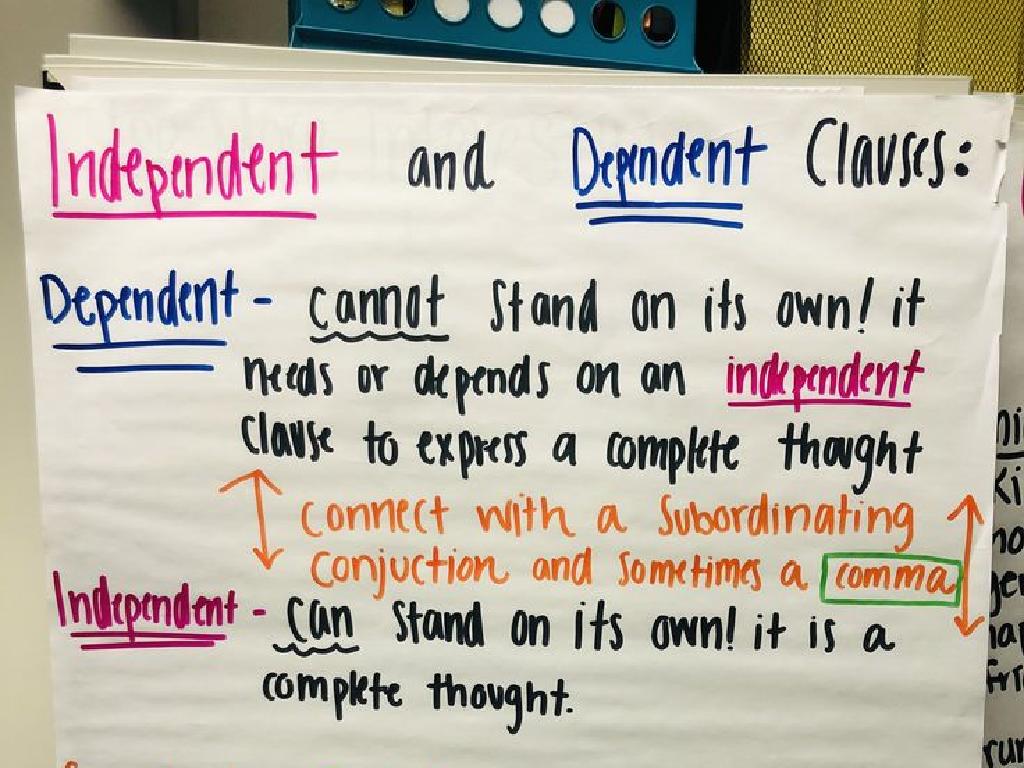Choose Between Adjectives And Adverbs
Subject: Language arts
Grade: Eighth grade
Topic: Adjectives And Adverbs
Please LOG IN to download the presentation. Access is available to registered users only.
View More Content
Introduction to Adjectives and Adverbs
– Define adjectives and adverbs
– Adjectives describe nouns, e.g., ‘The quick brown fox.’
– Explore their roles in sentences
– Adverbs modify verbs, adjectives, or other adverbs, e.g., ‘He ran quickly.’
– Examine adjectives in context
– ‘The lazy dog’ – ‘lazy’ describes the dog.
– Analyze adverbs in sentences
– ‘She speaks loudly’ – ‘loudly’ describes how she speaks.
|
This slide introduces the fundamental concepts of adjectives and adverbs in the English language. Begin by defining adjectives as words that describe or modify nouns and pronouns, giving more information about an object’s size, shape, age, color, etc. Then, define adverbs as words that modify verbs, adjectives, or other adverbs, often ending in ‘-ly,’ which tell us how, when, where, how often, or to what extent something is done. Provide clear examples for both, ensuring students understand how to identify and use them in sentences. Encourage students to think of additional examples and discuss how the meaning of a sentence changes with different adjectives and adverbs.
Understanding Adjectives
– Adjectives modify nouns
– They describe or give more information about nouns
– Answer ‘Which?’, ‘What kind?’, ‘How many?’
– They help specify and clarify nouns
– Examples: ‘blue’ sky, ‘seven’ apples
‘Blue’ describes the color of the sky, ‘seven’ specifies the number of apples, ‘happy’ tells the mood of the child
– Practice identifying adjectives
|
This slide introduces adjectives to the students, explaining their role in sentences as words that modify nouns. It’s crucial to highlight that adjectives are used to describe, quantify, and identify nouns, and they answer specific questions about the nouns they modify. Provide clear examples to illustrate the use of adjectives in sentences. Encourage students to practice by identifying adjectives in sentences and explaining the additional information they provide about the nouns. This will help them understand how adjectives enhance descriptions and contribute to more vivid and precise language.
Understanding Adverbs in Sentences
– Adverbs modify verbs, adjectives, or adverbs
– They add detail to describe actions or qualities
– Answer ‘How?’, ‘When?’, ‘Where?’, ‘To what extent?’
– Adverbs often end in ‘-ly’, but not always
– Example: He ran ‘quickly’
– Describes running with speed
– Example: She is ‘very’ smart
– ‘Very’ intensifies the adjective ‘smart’
|
This slide aims to clarify the role of adverbs in sentences for eighth-grade students. Adverbs are versatile words that modify not just verbs but also adjectives and other adverbs, providing more detail and nuance to a statement. They can answer questions about the manner, time, place, and degree of an action or quality. Examples like ‘quickly’ and ‘very’ illustrate common adverbs and their usage. Encourage students to think of adverbs as the words that give color and specificity to other words, enhancing the reader’s understanding of the situation or characteristic being described.
Choosing Between Adjectives and Adverbs
– Adjectives describe nouns
– E.g., ‘The quick brown fox’ – ‘quick’ and ‘brown’ describe ‘fox’
– Adverbs modify verbs, adjectives, or adverbs
– E.g., ‘He ran quickly’ – ‘quickly’ modifies ‘ran’
– Interactive identification activity
– We’ll practice picking out adjectives and adverbs from example sentences.
– Understanding usage in sentences
|
This slide aims to clarify the difference between adjectives and adverbs for the students. Begin by explaining that adjectives are used to add detail to nouns, giving more information about a person, place, thing, or idea. Then, introduce adverbs as words that modify not just verbs but also adjectives and other adverbs, often ending in ‘-ly’. Use interactive examples on the board to help students identify adjectives and adverbs within sentences. For the activity, consider having students work in pairs to find and classify words in sentences you provide. This will help solidify their understanding of how adjectives and adverbs function within the context of a sentence.
Adjectives and Adverbs in Action
– Identify adjectives and adverbs in text
– Find describing words and modifiers in a story
– Effect of adjectives/adverbs on meaning
– See how they change the story’s impact
– Group activity: crafting sentences
– Use provided words to make new sentences
|
This slide aims to engage students in understanding and applying adjectives and adverbs. Start by explaining the role of adjectives and adverbs, highlighting how they modify nouns and verbs, respectively. Provide a short story and guide students to identify the adjectives and adverbs within it. Discuss as a class how these words affect the meaning and tone of the sentences. For the group activity, divide the class into small teams and give them a list of adjectives and adverbs. Each group will create sentences using the words from the list, which will help them grasp the practical usage of these parts of speech. Encourage creativity and sharing among groups to foster a collaborative learning environment.
Common Mistakes: Adjectives vs. Adverbs
– Adjectives vs. adverbs confusion
– Adjectives describe nouns, while adverbs modify verbs, adjectives, or other adverbs.
– ‘slow’ vs. ‘slowly’ usage
– ‘slow’ describes a noun, ‘slowly’ describes how an action is performed.
– Practice: Sentence correction
– Find and fix errors in provided sentences.
– Understand common errors
|
This slide aims to highlight common errors students make when choosing between adjectives and adverbs, especially those with similar forms. Emphasize the difference in usage: adjectives are used to describe nouns and pronouns, while adverbs describe verbs, adjectives, or other adverbs. Provide clear examples, such as ‘slow’ to describe a noun (e.g., slow turtle) and ‘slowly’ to describe the manner in which an action is done (e.g., he walks slowly). The practice activity involves correcting sentences with these mistakes to reinforce learning. Encourage students to explain why a choice is correct or incorrect to deepen their understanding.
Class Activity: Adjective and Adverb Hunt
– Find adjectives and adverbs in lyrics or a book
– Look for descriptive words in songs or books
– Explain your choices
– Why did you pick these words? How do they enhance the sentence?
– Share with the class
– Discuss the role of each word in context
– Reflect on the activity
|
This activity is designed to help students practice identifying adjectives and adverbs within the context of language they enjoy, such as song lyrics or book paragraphs. Encourage students to choose a piece of text they are familiar with and to look for words that describe nouns (adjectives) or modify verbs, adjectives, and other adverbs (adverbs). They should consider the function of these words in the sentence: Does it describe a thing or person? Does it tell us how, when, where, or to what extent an action is performed? After identifying the words, students will explain their reasoning and share their findings with the class, fostering a collaborative learning environment. As a reflection, ask students how this activity might help them in their writing or in understanding texts they read.






